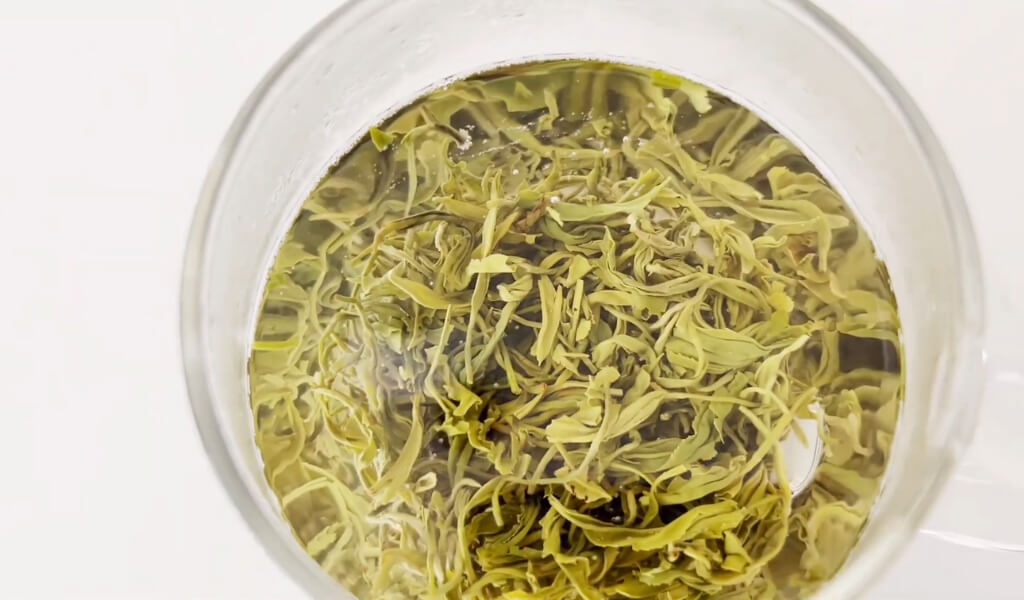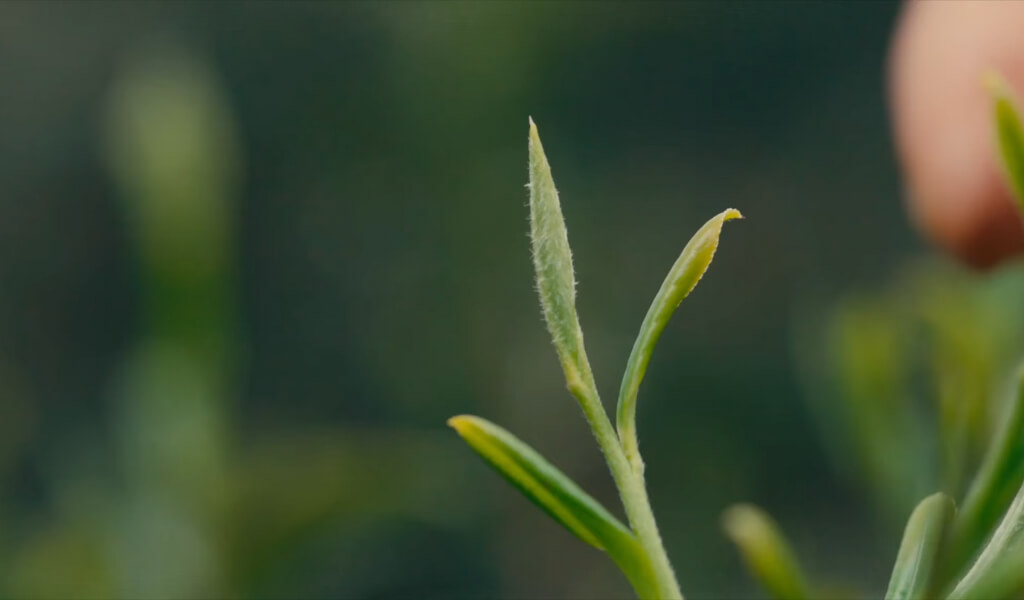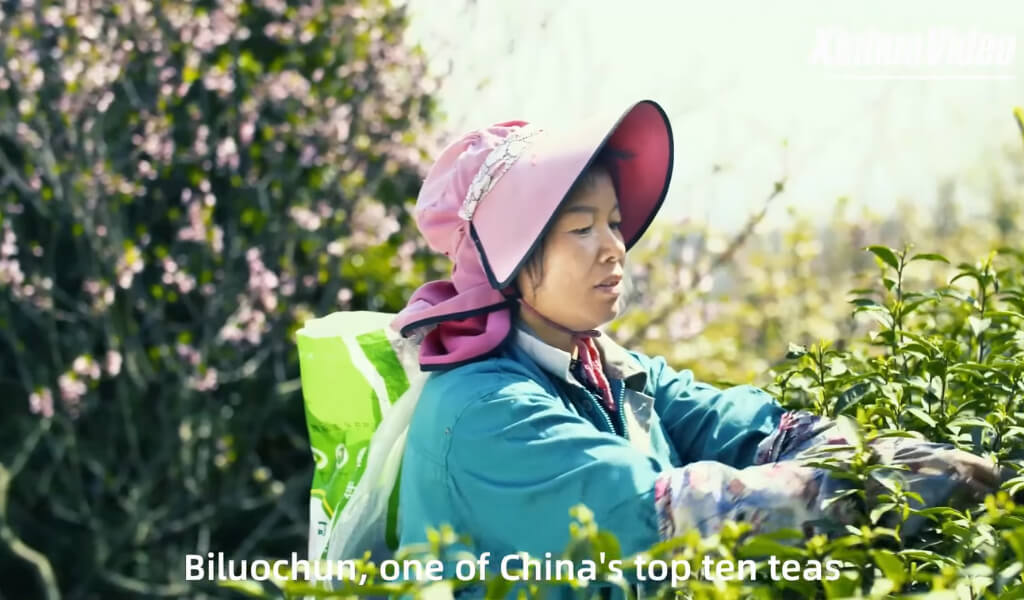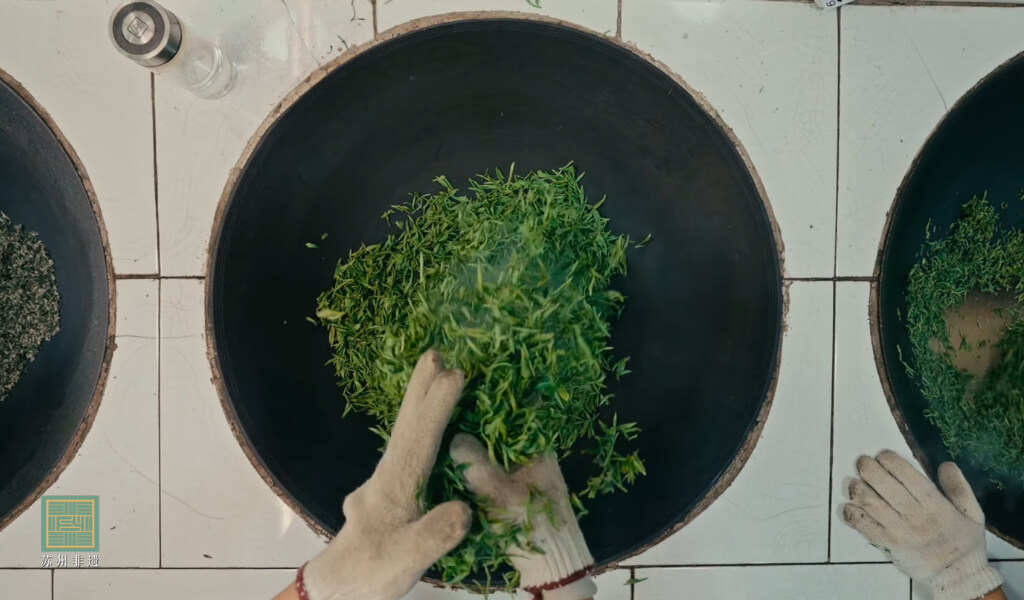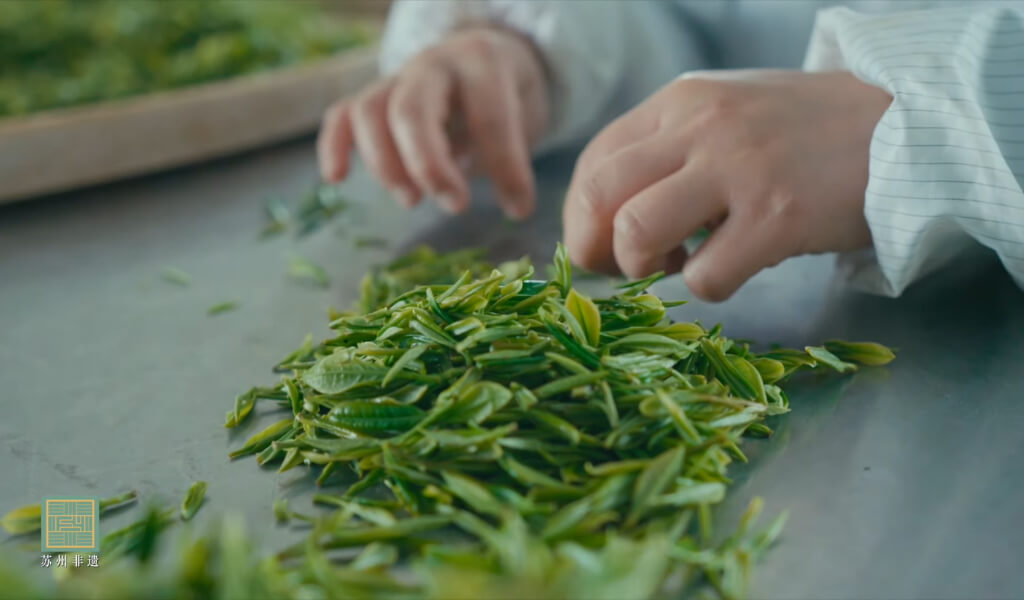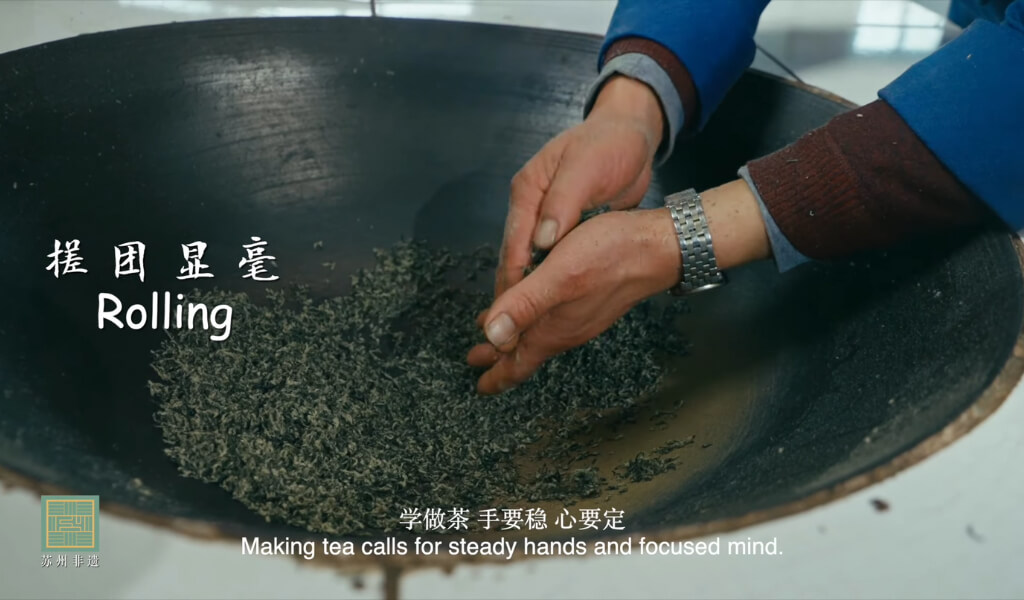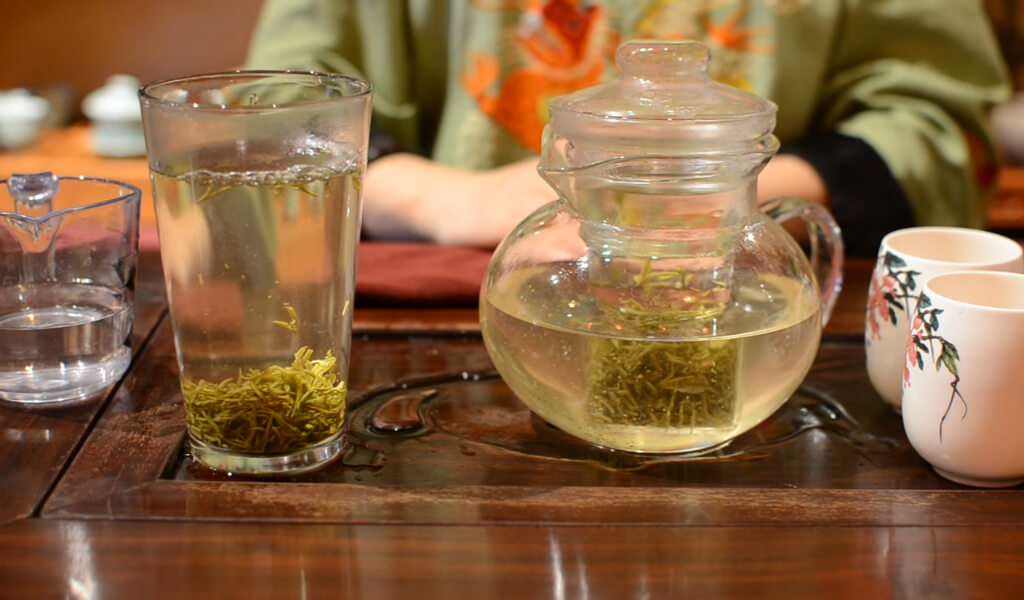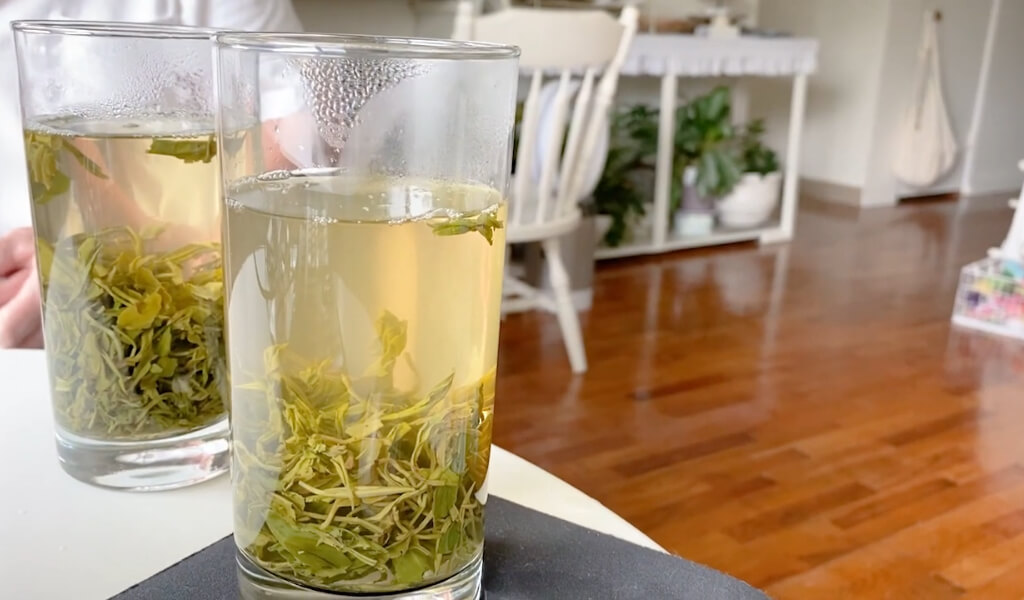You’ve likely heard the question, “What is Biluochun tea?” and might have been intrigued, as I was, about this unique and flavorful beverage.
As a fan of teas for many years, I’m thrilled to share my knowledge about this remarkable Green tea from China. Unlike your everyday tea, Biluochun is a hidden gem with a rich history, a unique flavour profile, and many health benefits.
What is Biluochun Tea?
Biluochun, or Bi Luo Chun (Chinese: 碧螺春), is a distinctive variety of Green tea hailing from the Dongting mountain area near Lake Tai, nestled in the heart of Suzhou, Jiangsu, China. This region, known for its lush, fertile landscapes, is a haven for producing high-quality teas.
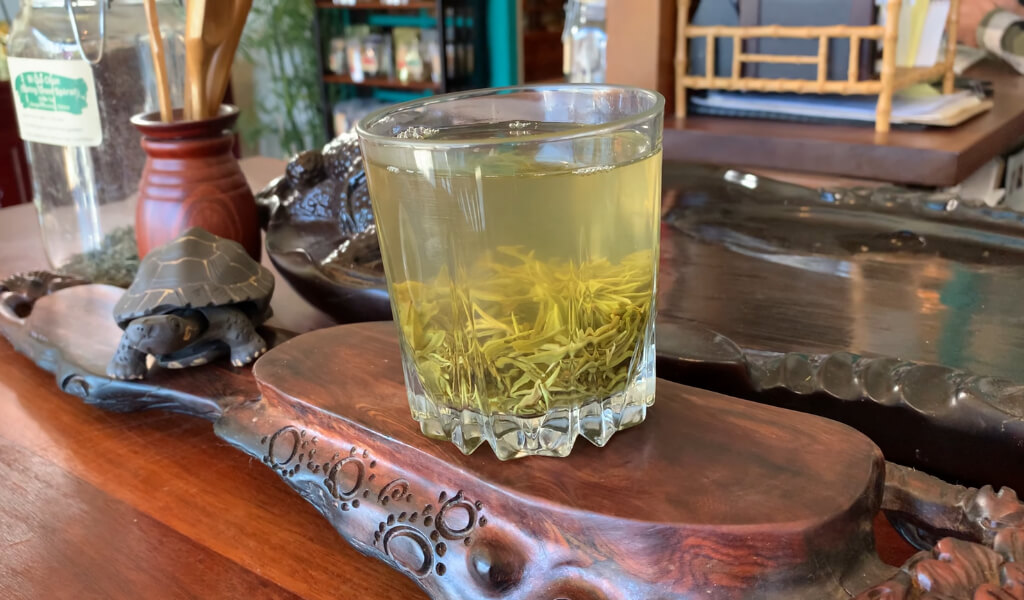
Biluochun tea, affectionately known as Pi Lo Chun, has gained a renowned reputation due to its captivating qualities. These include its delicate appearance, fruity flavor, enchanting floral scent, distinctive white fuzz, and the fact that it is harvested early in the spring.
The name “Biluochun” translates to “green snail spring,” a fitting description for this green tea that takes on a tightly coiled shape resembling snail meat and is picked during the budding spring days.
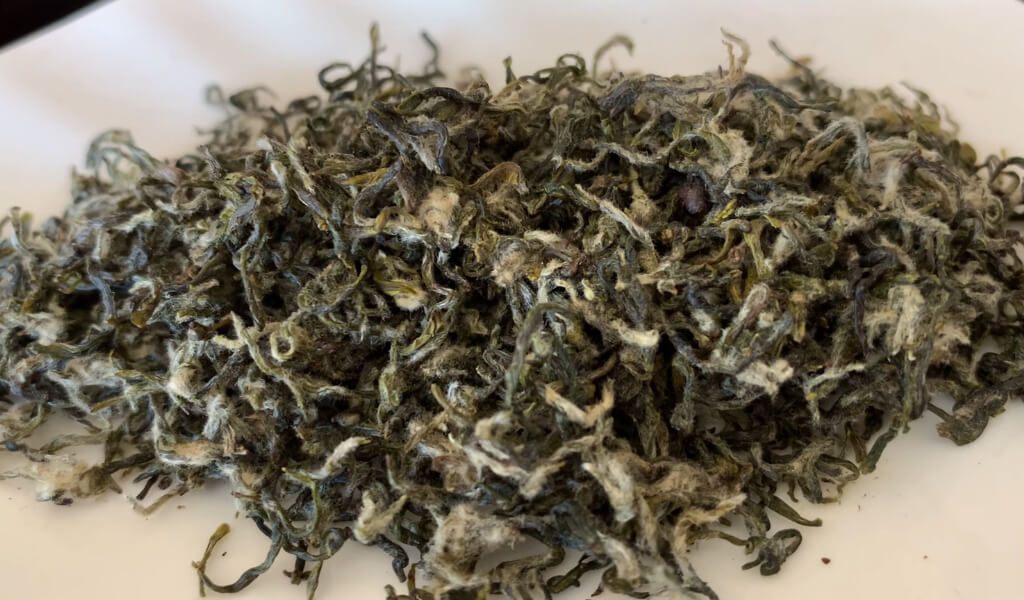
You might also encounter the term “Xia Sha Ren Xiang,” an ancient name for this tea that intriguingly means “scary fragrance.”
According to legend, a diligent tea picker, having filled her basket to the brim, stashed the surplus tea between her bosom. Warmed by her body heat, the tea released a potent aroma, startling the girl. This magical moment marked the beginning of Biluochun tea’s journey, which has since been savored by tea enthusiasts worldwide.
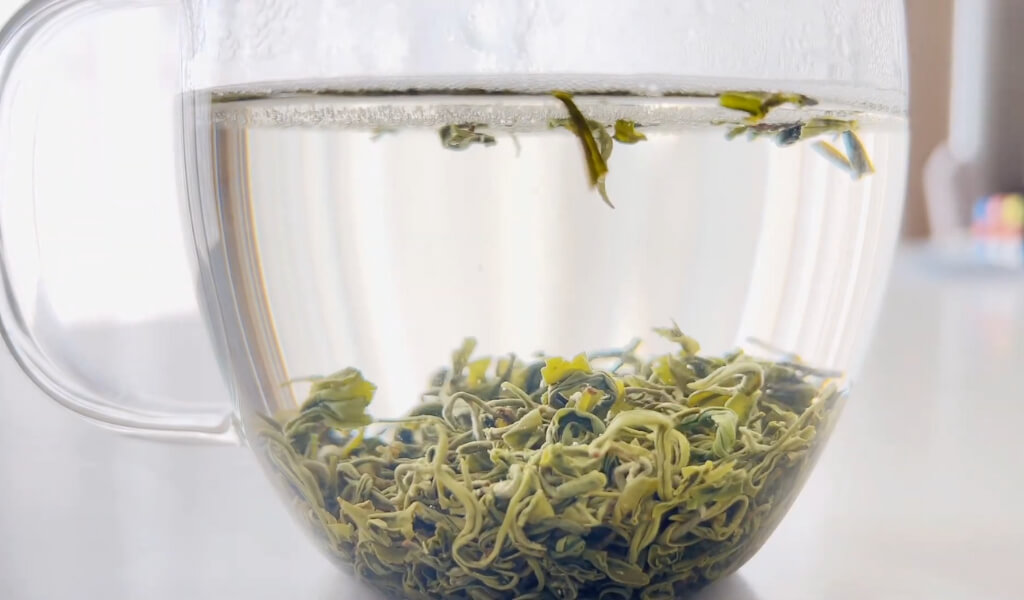
Now that you’re familiar with Biluochun tea let’s dive deeper into its origins and the rich history behind this exquisite brew.
Nutritional Facts
Biluochun tea is a treasure trove of nutrients, particularly antioxidants, crucial in protecting our bodies from harmful free radicals. The primary antioxidants in Biluochun are catechins, a type of polyphenol known for its health-promoting properties.
In addition to its antioxidant content, Biluochun is a source of essential vitamins and minerals. Among them are vitamin C, a key player in immune function, and minerals like potassium and magnesium, vital for maintaining heart and bone health.
Nutritious and delicious, Biluochun tea packs a punch. Now, let’s delve into the specific health benefits that make this tea a favoured choice among wellness enthusiasts.
History of Biluochun Tea
As documented in the respected Qing Dynasty chronicle, Ye Shi Da Guan, during the 38th year of his reign, the Kangxi Emperor embarked on a journey to Lake Tai.
The potent fragrance of a local tea, known then as “Scary Fragrance” due to its intense aroma, caught his attention. Recognizing its elegance, the emperor bestowed it with a more graceful name – “Green Snail Spring”, now known as Biluochun.
Respected experts in the world of Chinese tea, including Zhen Jun (1857-1918), a renowned author known for his extensive tea encyclopedia, Cha Shuo, have praised the exceptional quality of Biluochun tea. They have ranked it as the finest among Chinese green teas, closely followed by Longjing tea and Liu An Gua Pian. The delicacy and intricacy of Biluochun are such that it takes 14,000 to 15,000 tender tea shoots to produce just one kilogram of this tea.
Today, the Dongting Mountains near Lake Tai in Suzhou, Jiangsu, are acknowledged as the primary region for cultivating Biluochun tea. Within this area, the tea harvested from Dong Shan (East Mountain) and Xi Shan (West Mountain) is held in the highest esteem. However, Biluochun is not limited to Jiangsu; it is also grown in other provinces such as Zhejiang and Sichuan.
The leaves from these regions are larger and less consistent, often presenting a nuttier rather than fruity flavour. Finally, Biluochun cultivation has crossed the sea to Taiwan, specifically in the Sanxia District of New Taipei City, bringing this exquisite tea to an even wider audience.
Having discovered the rich history of Biluochun tea, let’s explore how this artisanal tea is produced, from cultivation to your teacup.
Read More:
- What is Sencha tea? Its Uses, Types Of Use, Buying and Storing
- What Dragon’s Well Tea? Its Types, Benefits And Brewing Tips
- What is Lu’An Melon Seed Tea? Origin, Characteristic & Health Benefits
- What is Lushan Yunwu Tea? Characteristic, Health Benefits & Brewing Tips
- What is Gunpowder Green Tea? Ultimate Benefits, Flavor & More
- What is Jasmine Tea? Origin, Tasting, Tea Made & Brewing
- Discover the Different Types of Green Tea: A Comprehensive Guide
How Biluochun Tea is Produced
Let me share some insight into this intricate process, blending in some firsthand experiences from my recent trip to China.
Cultivation and Harvesting Process
Biluochun green tea has some particular requirements when it comes to growing conditions. Its home, the Dongting Mountains of Suzhou, Jiangsu, provides a unique microclimate for Biluochun cultivation.
It was incredible to see during my visit. The terrain, rich in minerals and shrouded in mist, together with the temperate climate, forms the ideal environment for these delicate tea plants.
One aspect that makes Biluochun stand out is the specific harvesting time. The tea growers I met emphasised picking the leaves early in spring. The tender young leaves, harvested in this budding season, give Biluochun its signature delicate flavour and aroma.
Processing Techniques
Observing this firsthand was a highlight of my China trip. The tea leaves are usually pan-fired immediately after harvest, a technique that helps retain the vibrant green colour and prevents oxidation. Then, they are rolled into the characteristic “snail” shape.
What struck me the most was the level of meticulous attention given to ensuring the quality of Biluochun tea. Every step of the process, from carefully selecting the finest tea shoots to maintaining precise temperatures during the pan-firing, is executed flawlessly. The outcome is an exceptional tea that truly lives up to its prestigious reputation.
Keep in mind that when you savor a cup of Biluochun, you’re not simply indulging in a beverage; you’re participating in a rich legacy that is upheld with great care and dedication, spanning from the slopes of the Dongting Mountains to your teacup.
Let’s explore the various types of Biluochun tea next.
Types of Biluochun Tea
Did you know that Biluochun tea is classified into seven distinct grades, each signifying a different level of quality?
- Supreme
- Supreme I
- Grade I
- Grade II
- Grade III
- Chao Qing I
- Chao Qing II.
It’s wonderful to know that there’s a grade of Biluochun for every palate and every occasion.
Different grades of Biluochun tea offer unique experiences, but what remains constant is their nutritional content. Let’s discover what makes Biluochun tea not just delicious but also nourishing.
Biluochun Tea Benefits Tea
Aside from its delightful flavour and rich history, there are many Biluochun tea health benefits. So, not only does it soothe your taste buds, but it also contributes to your overall well-being. Let’s explore some of the key health advantages of this extraordinary tea.
Boosting Energy Levels
The caffeine in Biluochun tea stimulates the central nervous system and interacts with adenosine receptors, a process that can improve alertness and cognitive function. This makes Biluochun an excellent choice for enhancing mental performance during late-night study sessions or challenging work projects.
Supporting Weight Loss
In addition to the already mentioned compounds, Biluochun tea also contains Epigallocatechin gallate (EGCG), a catechin that has been researched for its role in boosting metabolism and potentially aiding weight loss. Moreover, the Vitamin B complex, including folic acid and pantothenic acid, can further support metabolism, adding to Biluochun tea’s potential as a weight management aid.
Cancer Prevention Potential
Alongside mulberry pigment and catechins, Biluochun tea contains other antioxidants, like quercetin and kaempferol. These substances have also been associated with potential anti-cancer effects, contributing to the growing body of research exploring tea’s potential as a part of a cancer-preventive diet.
Tooth Decay Prevention
The interaction between fluorine ions and calcium in teeth forms part of a larger process known as remineralisation, which is vital in maintaining dental health.
Biluochun tea contains catechins and flavonoids that possess antimicrobial properties. These substances can fight oral bacteria and provide an additional defense against tooth decay.
Antibacterial and Antimicrobial Properties
Tea polyphenols (TP) found in Biluochun tea, along with tannic acid, have demonstrated the ability to destabilise bacterial proteins, which can aid in eliminating harmful bacteria. This suggests that Biluochun tea could contribute to maintaining gut health and potentially support immune function, both crucial aspects of overall wellness.
Promoting Healthy Fluid Balance
Biluochun tea contains caffeine and theophylline, which can promote a natural diuretic effect. This could assist the body in dealing with fluid imbalances, making the tea a natural remedy for conditions like oedema or fluid retention.
Supporting Cardiovascular Health
Alongside tea polyphenols and vitamin C, Biluochun tea contains an EGCG (epigallocatechin gallate) powerful antioxidant. These compounds could play a role in promoting blood circulation, possibly reducing blood stasis. Consistent consumption of Biluochun tea might be associated with a lower risk of cardiovascular ailments, including high blood pressure and coronary heart disease.
Easing Symptoms of Beriberi
Interestingly, Biluochun tea also offers external benefits. Using it in a nightly foot bath routine may help ease symptoms like beriberi, primarily caused by thiamine (vitamin B1) deficiency. This aligns with traditional Chinese medicine practices, which often utilise nature’s gifts in versatile ways.
You might wonder about the Biluochun tea caffeine content after hearing about all these health benefits. Let’s discuss that next, as we examine the caffeine profile of Biluochun tea.
Dragon well tea caffeine
Biluochun tea typically contains approximately 35-70 milligrams of caffeine per 8-ounce serving. However, this amount can vary based on Biluochun tea ingredients, such as the specific type of Biluochun tea, how it’s brewed, and the steeping duration. The caffeine in Biluochun tea contributes to its energizing effects and can play a role in enhancing mental alertness and cognitive function.
Despite its caffeine content, it’s generally considered less potent than coffee, making it a more moderate option for those seeking a caffeine boost without the jitters often associated with coffee consumption.
Biluochun Tea Making
Just last Thursday, I brewed a splendid cup of Biluochun tea that was truly memorable. If you want to experience that same sensational flavour, follow the steps.
- Start with fresh, filtered water.
- Heat the water to 75-80 degrees Celsius.
- Add a teaspoon (3 grams) of Biluochun tea per cup.
- Pour the heated water over the tea leaves.
- Let the tea steep for 2-3 minutes.
- Enjoy your perfectly brewed Biluochun tea.
For serving, pair Biluochun tea with light pastries or savoury snacks.
For storage, follow these steps:
- Store in an airtight container.
- Keep at room temperature.
- Avoid direct sunlight, moisture, and strong odours.
Enjoy the art and flavour of your well-crafted Biluochun tea!
Now that you know how to make the perfect cup of Biluochun, you might be wondering where to buy this exquisite tea. Let’s look at your best options for purchasing Biluochun tea.
Biluochun tea where to buy
Looking to buy and enjoy its exquisite Biluochun tea taste at home? Also called Pi Lo Chun, this tea is famous for its delicate look, fruity flavor, floral scent, white hairs, and early harvest. It is a green tea with a strong aroma and a subtle floral taste.
Here are the details!
| Local Specialty Tea Shops |
Visit these stores for a hands-on shopping experience and a variety of Biluochun teas.
|
| Online Tea Stores |
Reliable and convenient, these offer detailed descriptions and reviews to help you choose the best Biluochun tea.
|
| E-commerce Platforms |
Large online retailers like Amazon provide a wide selection of Biluochun tea from different sellers worldwide.
|
| Direct From Producers |
For authentic Biluochun tea, consider buying directly from producers in China, offering an unmatched tea experience.
|
Conclusion: Why You Should Try Biluochun Tea
In conclusion, Biluochun tea is a unique beverage experience with its delicate flavour profile, rich history, and intriguing cultivation and processing methods.
One of China’s most famous green teas, Biluochun tea captivates with its signature ‘green snail spring’ spiral shape and its early spring harvest. The intricate artistry that goes into the cultivation, harvesting, and preparation of Biluochun tea makes it a standout in green teas.
Sampling Biluochun tea, you’ll immerse yourself in an engaging blend of fruity taste, floral aroma, and a unique smoothness that lingers on your palate. From its visual appeal to its rich, multi-faceted flavor, Biluochun tea provides a rewarding experience for tea novices and connoisseurs alike.
I encourage everyone to explore the delightful world of Biluochun tea. Whether you’re an experienced tea drinker seeking a new flavour to savor or a beginner wanting to venture into the world of premium teas, Biluochun tea is a must-try.
It’s not just a beverage; it’s an experience steeped in culture, tradition, and the simple joy of savoring nature’s bounty. Drink up, my friends. Your Biluochun adventure awaits!
Thanks for Spiritea Drinks
FAQs
What is Biluochun tea good for?
Biluochun tea is excellent for promoting overall health thanks to its rich antioxidant content, which helps to combat free radicals in the body. It also aids in improving cognitive function, reducing cholesterol, promoting weight loss, and potentially reducing the risk of certain cancers. Moreover, its caffeine content can help enhance alertness and combat fatigue.
How do you drink Biluochun?
Biluochun tea involves steeping the tea leaves in hot water, typically around 80-85 degrees Celsius (175-185 degrees Fahrenheit), for optimal flavour extraction. Let the tea steep for about 2-3 minutes, then enjoy it warm. Feel free to adjust the steeping time and water temperature according to your taste preferences.
What is Biluochun tea in English?
In English, Biluochun tea is often called “Green Snail Spring,” a literal translation of its Chinese name “碧螺春”. This name reflects the tea’s distinct characteristics: its vibrant green colour, unique snail-like rolled shape, and the fact that it’s harvested in the spring.
Is it OK to drink Biluochun tea every day?
Yes, it’s generally safe to drink Biluochun tea every day. Regular consumption can provide various health benefits due to its high antioxidant and vitamin content. However, as Biluochun tea does contain caffeine, those sensitive to it should monitor their intake.
What are the side effects of Biluochun tea?
Some individuals may experience side effects due to its caffeine content. Potential side effects include restlessness, insomnia, irregular heartbeat, or increased blood pressure, especially when consumed excessively.
What is the best time of day to drink Biluochun tea?
Biluochun tea can be enjoyed any time of day. However, due to its caffeine content, some people may prefer to drink it in the morning or early afternoon to avoid potential sleep disturbances.
How can I tell if my Biluochun tea is of high quality?
High-quality Biluochun tea will have tender, uniform leaves with a vibrant green color and a coating of fine, white hairs. It should also offer a fruity, floral aroma and a sweet, smooth flavor.
I’m Shanna, creator of Spiritea Drinks. I’m all about teaching people to grow their own food, tea, cook what they harvest, and eat with the seasons.

